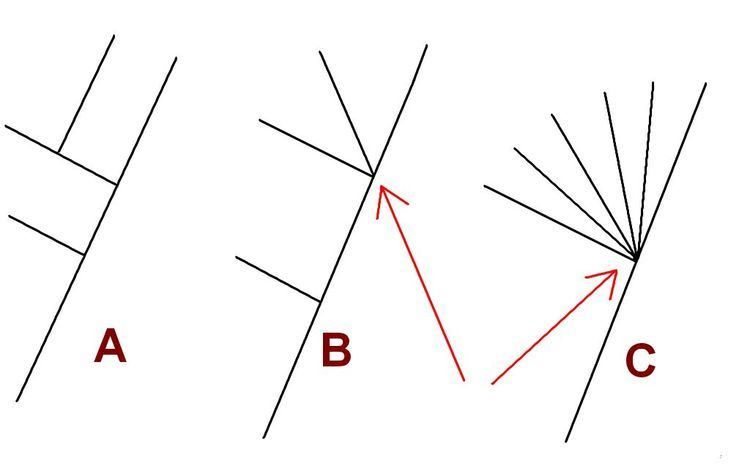 | ||
In biology, a polytomy /pəˈlɪtəmi/ is a section of a phylogeny in which the relationships cannot be fully resolved to dichotomies, thus presenting an unlikely picture of many apparently simultaneous temporally based branches. A polytomy thus presents an analytical problem, but can usually be better studied with more flexible phylogenetic network software such as SplitsTree, which can represent some polytomies as median networks.
Contents
Soft polytomies vs. hard polytomies
Two types of polytomies are recognised, soft and hard polytomies. Soft polytomies are the result of insufficient phylogenetic information: though the lineages diverged at different times – meaning that some of them are closer relatives than others – the available data does not allow recognition of this. Most polytomies are soft, meaning that they would be resolved into a typical tree of dichotomies if better data were available.
In contrast, hard polytomies represent three or more simultaneous speciation events from the same common ancestor, so the resultant daughter species are equidistant from each other. In particular situations they may be common, for example when a species that has rapidly expanded its range or is highly panmictic undergoes peripatric speciation in different regions.
An example is the Drosophila simulans species complex. Here, the ancestor seems to have colonized two islands at the same time but independently, yielding two equally old but divergently evolved daughter species.
Recognizing hard polytomies
As DNA sequence evolution is usually much faster than evolution of complex phenotypic traits, it may be that genetic lineages diverge a short time apart from each other, while the actual organism has not changed if the whole ancestral population is considered. Since few if any individuals in a population are genetically alike in any one population – especially if lineage sorting has not widely progressed – it may be that hard polytomies are indeed rare or nonexistent if the entire genome of each individual organism is considered, but rather widespread on the population genetical level if entire species are considered as interbreeding populations (see also species concept).
Note that "speciation or lineage divergence events occurring at the same time" refers to evolutionary time measured in generations, as this is the only means that novel traits (e.g. germline point mutations) can be passed on. Also note that in practical terms, our ability to distinguish between hard and soft polytomies is limited: if for example a kilobase of DNA sequences which mutate approximately 1% per million years is analysed, lineages diverging from the same ancestor within the same 100,000 years cannot be reliably distinguished as to which one diverged first.
In that respect, it is also important to realize that founder effects and genetic drift may result in different rates of evolution. This can easily confound molecular clock algorithms to the point where hard polytomies become unrecognizable as such.
